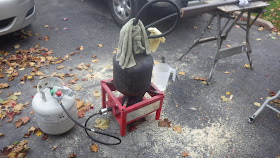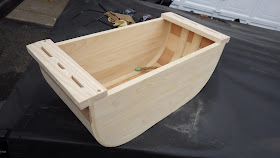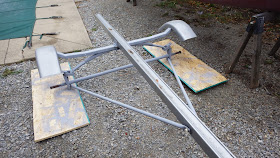Way back when i first read Building the Maine Guide Canoe, i recall that Thurlow and Stelmok noted on page 64 that an old galvanized water tank, with a slot cut in it, was a great way to boil stem stock. Birchbark builders will drop ribs in hot water to make them more pliable, and stem stock boiled and bent is given as an option to soaking and steaming (which can dry the wood out). Soaking ribs the night before bending usually found them in the bath tub, but the tubs too short and it can lead to scheduling conflicts. We needed an older galvanized water tank, of course, soak ribs, and suspend over the gas burner to boil stems and such.
While we've been trying to replace modern plastic and lightweight equipment with older cast iron machinery, remembering back to hunting years ago there was an old shack in a sugar bush deep in the woods that had fallen down decades before we used to frequent the spot deer hunting, and i hadnt been back in 20 years.
Could we find it? Would it be rusted beyond use, laying on its side as it had for decades, and was the last time we saw it 20+ years ago?
Off we went, looking for ruffed grouse along the way.
After a fruitless search 2 weeks earlier, things started to look familiar this time, and eventually we walked up on it.
Usually hunting this bush in mid November the bush is bare, but this time of fall there's still lots of leaves and green were present, making the search a little more difficult as vision was limited.
Sure enough we found it.
A tree fell on it, one half on the ground, but found to be completely rust free, and in perfect shape. Likely brought in on by horse and/or on a sled all those years ago, the cabin and debris long gone.
We were able to locate one of the trash piles, and the tin hasnt fared as well as the tank. The galvanizing, like most things, was done to last in the old days.
Usually separated, glass and steel would be in separate piles, but this being a temporary endeavour in a maple sugar bush, likely not much glass ever made it in during the short stays.
Success! and a spot from my youth shared. We'll be back, looking for deer and just wandering .
As Tolkien said, not all who wander are lost.
Industrial/Steampunk/Vintage, whatever you call it a fully riveted pressure tank with over 200 rivets is a wicked nice addition to a shop filled with vintage tools.
Steve Cayard, bark canoe builder extraordiaire, putting ribs into a tank of boiling water to make them more pliable.















































